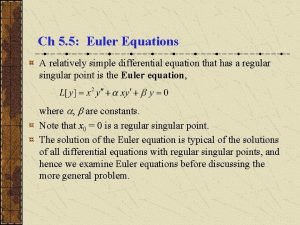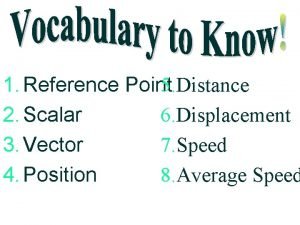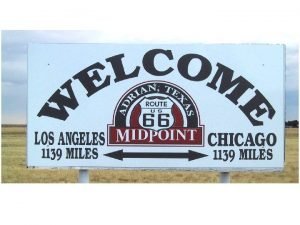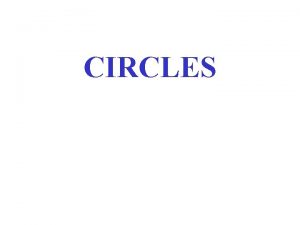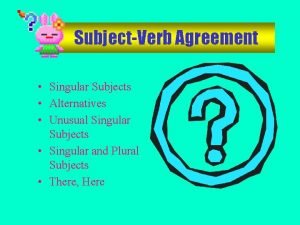MULTIPLE POINTS Art 1 Singular Point Def A













- Slides: 13

MULTIPLE POINTS Art. 1. Singular Point Def. A point on the curve at which the curve exhibits an extraordinary behavior is called a Singular Point. Types of Singular Points. (i) Points of inflexion (ii) Multiple Points. Art. 2. Multiple Point Def. A Point on the curve through which more than one branch of the curve pass is called Multiple Point. Double Point : Def. A Point on the curve through which two branches of the curve pass is called Double Point. Triple Point : Def. A Point on the curve through three branches of the curve pass is called Triple Point. Multiple Point of rth order. Def. A Point on the curve through which r branch of the curve pass is called Multiple Point of rth order.

Art. 3. Kinds of Double Points (i) Node : Def. A Double Point P on a curve is called a Node if two real branches of a curve pass through P and two tangents at which are real and different. Thus the point P shown in fig. is a Node. Y P O X

(ii) Cusp : Def. A Double Point Q on a curve is called a Cusp if two real branches of a curve pass through Q and two tangents at which are real and coincident. Y Y Q O Q X O X Thus the point Q shown in the adjoining two figures is a Cusp.

(iii) Conjugate Point or Isolated point. Def. A Double Point R on a curve is called a Conjugate Point or Isolated point if there exists no real points of the curve in the neighborhood of R Y R O X

Art. 4. Tangents at the origin Rule. The tangents at the origin are obtained by equating to zero the lowest degree terms present in the equation of the given curve. Art. 5. Working rule for investigating the nature of the double point at the origin. 1. Find the tangents at the origin by equating to zero the lowest degree terms present in the equation of the curve. If origin is a double point, then we shall get tangents real and imaginary. 2. If the two tangents at the origin are imaginary, then the origin is a conjugate point. 3. If the two tangents at the origin are real and different, then the tangent is a node or a conjugate point. 4. If the two tangents at the origin are real and coincident, then the origin is a cusp or a conjugate point.

To study the nature of the curve near origin (a) If the tangents at the origin are y²=0, solve the equation of the curve for y, neglecting all terms of y having powers above second. If for small non zero values of x, the values of y are real, then the branches of the curve through the origin are also real, otherwise they are imaginary. (b) If the tangents at the origin are x²=0, solve the given equation of the curve for x instead of y and proceed as in (a) above. (c) In other cases, solve for y or x, whichever is convenient. Art. 6. Conditions for the existence of Multiple Points For Multiple Points of the curve ƒ(x, y) = 0, ∂ƒ/∂x = 0 and ∂ƒ/∂y = 0.

Art. 1. Integrals of Hyperbolic and Inverse hyperbolic Functions List of important definitions and properties of Hyperbolic Functions The following important definitions and properties of Hyperbolic Functions are : (i) sinhx = (ex – e-x); coshx = (ex +e-x); 2 2 tanhx = (ex – e-x); cothx = (ex + e-x) ; (ex +e-x) (ex - e-x) sechx = 2 cosechx = 2 ; (ex +e-x) (ex – e-x) (ii) cosechx = 1/ sinhx; sechx = 1/ coshx; cothx = 1/tanhx. (iii) cosh 2 x – sinh 2 x = 1; sech 2 x + tanh 2 x = 1; coth 2 x – cosech 2 x = 1.

1. (iv) (v) sinh(x ± y) = sinhx coshy ± coshx sinhy cosh(x ±y) = cosh x cohy ± sinhx sinhy sinh(x+y) sinh(x-y) = sinh²x – sinh²y cosh(x+y) cosh(x-y) = cosh²x + sinh²y sinh 2 x = 2 sinhx coshx = 2 tanhx 1 -tanh²x cosh 2 x = cosh²x + sinh²x or 2 cosh²x – 1 or 1 + 2 sinh²x or 1 + tanh²x 1 - tanh²x

cosh²x = 1 + cosh 2 x , sinh²x = cosh 2 x - 1 2 2 tanh 2 x = 2 tanhx. 1 + tanh²x (vi) sinhx + sinhy = 2 sinh(x +y) cosh(x –y) 2 2 sinhx - sinhy = 2 cosnh(x +y)/2 sinh(x –y)/2 coshx + coshy = 2 cosh(x +y)/2 cosh(x –y)/2 coshx - coshy = 2 sinh (x +y)/2 sinh (x –y)/2 (vii) 2 sinh A cosh B = sinh (A + B) + sinh (A – B) 2 cosh A sinh B = sinh (A + B) – sinh (A –B) 2 cosh A cosh B = cosh (A + B) + cosh (A - B) 2 sinh A sinh B = cosh (A + B) – cosh (A - B) (viii) d sinh x = cosh x; d cosech x = - cosech x coth x dx dx d cosh x = - sinh x; d sech x = sech x tanh x dx dx

d tanhx = sech²x; d cothx = - cosec²hx dx dx (ix) d sinh-1 x = 1. dx √ 1 + x² d cosh-1 x = 1. For x > 1, cosh-1 x >0 dx √x² - 1 d cosh-1 x = -1. For x > 1, cosh-1 x <0 dx √x² - 1 d tanh-1 x = 1 , |x| < 1 dx 1 - x² d coth-1 x = 1 , |x| > 1 dx 1 – x² d sech-1 x = -1 , 0< x < 1 dx x√ 1 - x² d cosech-1 x = -1 , x≠ 0 dx |x|√ 1 + x²

Art. 2. Basic Results. (i) (iii) (iv) (vi) ∫ sinh x dx = cosh x + c ∫ cosh x dx = sinh x + c ∫ sech² x dx = tanh x + c ∫ cosech² x dx= - coth x + c ∫ sech x tanh x dx = - sech x + c ∫ cosech x coth x dx = - cosech x + c Art. 3. Standard Results. (i) (iii) (iv) ∫ tanh x dx = log cosh x + c ∫ coth x dx = log |sinhx| + c, x ≠ 0 ∫ sech x dx = tan-1(sinhx) + c ∫ cosech x dx = 1 log cosh x – 1 + c, x ≠ 0 2 cosh x + 1

Art. 4. Some More Results. (i) ∫ 1 dx = sinh-1 x + c √x² + 1 (ii) ∫ 1 dx = cosh-1 x + c, x > 1 √x² - 1 (iii) ∫ 1 dx = tanh-1 x + c, |x| < 1 1 - x² (iv) ∫ 1 dx = coth-1 x + c, |x| > 1 1 - x²

Art. 5 Standard Integrals Involving Inverse Hyperbolic Functions. (i) ∫ 1 dx = sinh-1(x/a) + c √a² + x² (ii) ∫ 1 dx = cosh-1(x/a) + c, |x| > a √x² - a² (iii) ∫ √(a² + x² ) dx = x. √(a² + x²) + a² sinh-1 x + c 2 2 a (iv) ∫ √(x² - a² ) dx = x. √(x² - a²) - a² cosh-1 x + c 2 2 a (v) ∫ 1 dx = 1 tanh-1(x/a) + c; where |x| < a a² - x² a = 1 coth-1(x/a) + c; where |x| >a a
 Multiple point perspective art
Multiple point perspective art Measurement subject verb agreement
Measurement subject verb agreement It is a moving point towards certain direction
It is a moving point towards certain direction Brand positioning bulls eye
Brand positioning bulls eye Points of parity and points of difference
Points of parity and points of difference Multiple baseline vs multiple probe design
Multiple baseline vs multiple probe design Advantages and disadvantages of mimd
Advantages and disadvantages of mimd The singular point of every euler equation is
The singular point of every euler equation is Displacement symbol
Displacement symbol The point halfway between the endpoints of a line segment
The point halfway between the endpoints of a line segment The set of all points equidistant from a single point
The set of all points equidistant from a single point Name all rays
Name all rays Multiple point calibration adalah
Multiple point calibration adalah Contemporary frameworks
Contemporary frameworks







